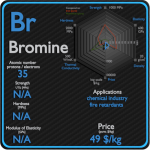This article contains comparison of key thermal and atomic properties of oxygen and potassium, two comparable chemical elements from the periodic table. It also contains basic descriptions and applications of both elements. Oxygen vs Potassium.

Oxygen and Potassium – About Elements


Source: www.luciteria.com
Oxygen and Potassium – Applications
Oxygen
Common uses of oxygen include production of steel, plastics and textiles, brazing, welding and cutting of steels and other metals, rocket propellant, oxygen therapy, and life support systems in aircraft, submarines, spaceflight and diving. Smelting of iron ore into steel consumes 55% of commercially produced oxygen. In this process, oxygen is injected through a high-pressure lance into molten iron, which removes sulfur impurities and excess carbon as the respective oxides, sulfur dioxide and carbon dioxide. Uptake of oxygen from the air is the essential purpose of respiration, so oxygen supplementation is used in medicine. Treatment not only increases oxygen levels in the patient’s blood, but has the secondary effect of decreasing resistance to blood flow in many types of diseased lungs, easing work load on the heart.
Potassium
Potassium (K) is an essential nutrient for plant growth. It’s classified as a macronutrient because plants take up large quantities of K during their life cycle. Agricultural fertilizers consume 95% of global potassium chemical production, and about 90% of this potassium is supplied as KCl. Due to its high degree of reactivity, pure potassium is rarely used in its elemental /metallic form. It is used as a powerful reducing agent in organic chemistry. Potassium/Sodium alloys are It used as a heat exchange medium . The heat in the potassium warms water and makes it hot enough to boil. Then water is changed into steam, which is used to work devices that generate electricity.
Oxygen and Potassium – Comparison in Table
| Element | Oxygen | Potassium |
| Density | 0.00125 g/cm3 | 0.856 g/cm3 |
| Ultimate Tensile Strength | N/A | N/A |
| Yield Strength | N/A | N/A |
| Young’s Modulus of Elasticity | N/A | 3.53 GPa |
| Mohs Scale | N/A | 0.4 |
| Brinell Hardness | N/A | 0.36 MPa |
| Vickers Hardness | N/A | N/A |
| Melting Point | -209.9 °C | 63.25 °C |
| Boiling Point | -195.8 °C | 760 °C |
| Thermal Conductivity | 0.02598 W/mK | 102.4 W/mK |
| Thermal Expansion Coefficient | N/A | 83 µm/mK |
| Specific Heat | 1.04 J/g K | 0.75 J/g K |
| Heat of Fusion | (N2) 0.7204 kJ/mol | 2.334 kJ/mol |
| Heat of Vaporization | (N2) 5.56 kJ/mol | 79.87 kJ/mol |


















